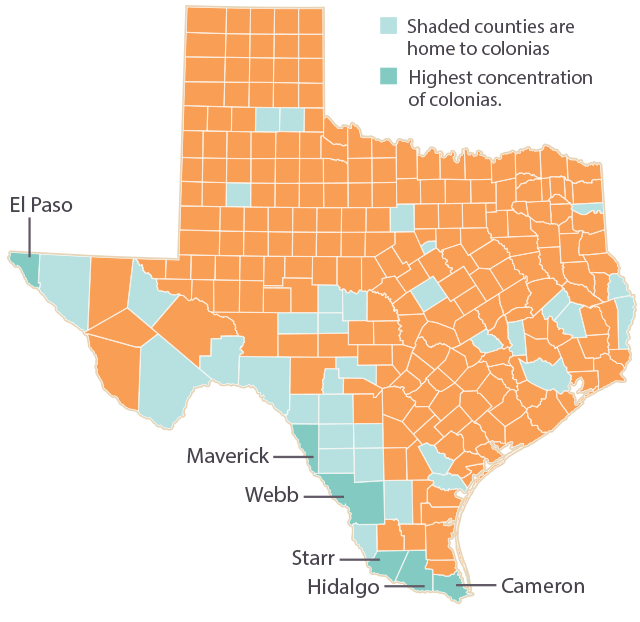Background
What is a colonia?

A Texas colonia dwelling
In Spanish, colonia means a community or neighborhood. In the U.S., along the Mexico border, the term has an additional meaning. The Texas Office of the Secretary of State defines a colonia as a residential area along the Texas–Mexico border that may lack basic living necessities, such as:
- Potable water
- Sewer systems
- Electricity
- Paved roads
- Safe housing
There are also colonias in Arizona, New Mexico and California, but Texas has the largest colonias population. An estimated 500,000 people live in 2,294 Texas colonias, which represents one of the largest concentrations of poverty in the U.S.
1996 Dallas Fed Texas Colonias Study

The Dallas Fed has been involved in efforts to bring attention to the needs of the colonias since conducting its first study of these communities and releasing its 1996 report, “Texas Colonias: A Thumbnail Sketch of the Conditions, Issues, Challenges and Opportunities.” This publication has been widely used by government and community organizations and others seeking information on Texas colonias.
2015 Dallas Fed Texas Colonias Study

SOURCE: Texas Commission on Environmental Quality, 2013.
To provide an update on successes and challenges that have occurred in Texas colonias since the 1996 report, the Community Development Department of the Dallas Fed conducted a comprehensive study of colonias in the six Texas counties with the highest concentration of colonias:
- El Paso County
- Maverick County
- Webb County
- Starr County
- Hidalgo County
- Cameron County
Methodology: Quantitative and Qualitative Research*
The study relied on traditional quantitative data but also incorporated qualitative research methods to reveal a more multidimensional picture of colonias and their residents.
Quantitative data was drawn from the 2010 Census, the 2011 American Community Survey, the Texas Attorney General, the Texas Secretary of State, the Texas Department of Housing and Community Affairs and the Texas Department of State Health Services.
Qualitative data was gathered by conducting in-depth interviews and focus groups of residents, service providers and community leaders along the 1,250-mile Texas–Mexico border, in the six counties listed above.
*See the 2015 report for an extensive description of the methodology.
Steering Committee
The Dallas Fed formed a steering committee to guide fieldwork and connect the research team with key stakeholders for interviews.

Report
The Dallas Fed released its latest report, “Las Colonias in the 21st Century: Progress Along the Texas–Mexico Border” in April 2015.
The report examines successes, challenges and opportunities in these communities in the focus areas of:
It highlights progress made by community organizers, residents, elected officials, nonprofits and government agencies to improve living conditions in Texas colonias, as well as needs that still remain.
| Demographics in Colonias Differ From Texas and U.S. | ||||
| Colonias sample † | Texas | U.S. | ||
| Basic demographics | Age (median) | 27 | 33.6 | 37.2 |
| Hispanic or Latino (%) | 96.0 | 37.6 | 16.3 | |
| Speak English less than very well (%) | 43.3 | 14.50 | 8.71 | |
| Foreign born (%) | 34.8 | 16.2 | 12.8 | |
| Citizenship status (%) | Citizenship rate under 18 | 94.1 | 95.6 | 97.0 |
| Citizenship rate 18 and older | 60.8 | 86.6 | 91.4 | |
| Citizenship rate, all ages | 73.1 | 89.1 | 92.8 | |
| Educational attainment, population 25 and older (%) |
Less than high school diploma | 54.8 | 19.6 | 14.6 |
| High school diploma | 23.4 | 25.7 | 28.6 | |
| Some college | 16.4 | 28.7 | 28.6 | |
| College degree or higher | 5.5 | 26.1 | 28.2 | |
| Employment status, population 16 and older (%) | Employment-to-population ratio | 50.4 | 60.2 | 58.8 |
| Unemployment rate | 10.8 | 7.3 | 8.7 | |
| Not In labor force | 43.2 | 34.5 | 35.2 | |
| Household income ($) | Median income | 28,928 | 50,920 | 52,762 |
| Poverty status (%) | Poverty rate | 42.0 | 17.0 | 14.3 |
| Near-poverty rate* | 19.4 | 10.9 | 9.2 | |
| Government assistance (%) | Public assistance or food stamps | 40.3 | 11.6 | 11.0 |
| † Colonia sample is based on available census data and includes colonia residents from Cameron, El Paso, Hidalgo, Maverick, Starr and Webb counties. *“Near poverty” is defined as 100 to 150 percent of the poverty line. SOURCES: Census Bureau, 2010 census unless otherwise noted for population, housing and age data; for all other demographic data, 2011 American Community Survey 5-Year Estimates. |
||||
Additional 2015 Resources

The majority of colonia residents are U.S. citizens.
Video
An accompanying video to the report provides an overview of the state of the colonias featured in the report as well as promising strategies to improve living conditions and access to opportunity in these communities.
Conference
A conference to convene colonia residents and stakeholders and highlight report findings was held in McAllen, Texas, in July 2015. At the event, local, regional and national experts presented on models of success for these Texas colonias.


